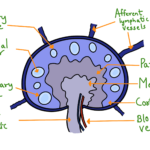Electrophoresis is a term referred to as the movement of charged molecules in an electric field. Agarose gel electrophoresis is commonly used to separate/purify larger DNA fragments. This technique is used to separate DNA fragments with 100 base pairs up to the length of 200kbp. The gel is composed of agarose. Agarose is a polysaccharide derived from seaweed. The agarose forms solid gels when dissolved in water in a fixed concentration. Agarose is a purified form of agar which is a common component of solid media. The principle of the agarose gel electrophoresis is that as DNA is a negatively charged particle when exposed to an electric field it will move towards a positively charged electrode. The rate at which this migration takes place depends on the size of the DNA fragment. Smaller fragments move much faster in the field as compared to larger ones. This agarose gel electrophoresis can be used to separate DAN fragments from a mixture based on their size. The pore size in agarose gels ranges from 100 to 300 nm. The pore size depends on the concentration of the agarose used. The greater the concentration of the agarose smaller is the size of the pores. Hence, agarose gel with a higher concentration of agarose is used for the separation of bigger DNA fragments such as genomic DNA. For the preparation of agarose gels, agarose is weighed and dissolved in water or TAE buffer. As agarose is not soluble in these solutions at room temperature, usually it is dissolved by heating the solution in the microwave. Once the agarose is dissolved, homogeneously Ethidium Bromide (EtBr) is added to the solution.
EtBr is a fluorescent molecule that gives fluorescence under UV light. When DNA moves through the gel, EtBr binds to the DNA molecule, which helps visualize DNA under UV light. A well is created in an agarose gel, and the DNA samples are loaded in that well. A buffer is poured on the top of the gel for charges to transfer. Samples are loaded by mixing them with loading dye which helps to monitor the migration. In case the size of the DNA fragment is not known, a mixture of known lengths of DNA fragments termed as DNA ladder is used. The DNA ladder is loaded in an adjacent well of the unknown sample, and the length is determined by comparing the band with the DNA ladder.



